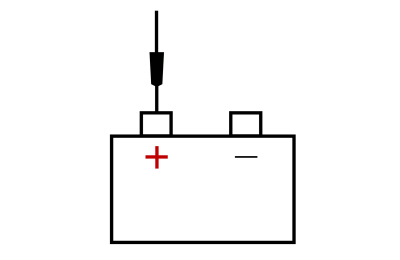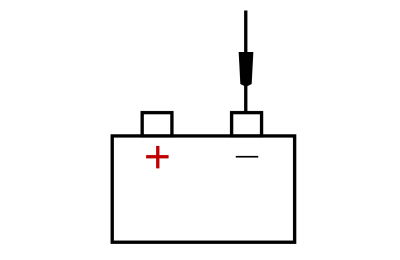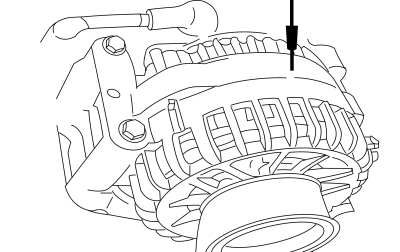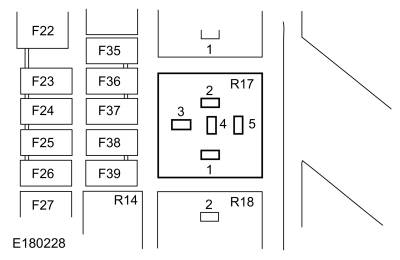Ford Ecosport: Charging System - General Information / Diagnosis and Testing - Charging System
Inspection and Verification
-
Verify the customer concern by operating the charging system.
-
Before diagnosing or repairing the charging system inspect the following items:
- Check the battery for loose, damaged or corroded connections.
- Check the generator for loose, damaged or corroded connections.
- Check engine and battery grounds for loose, damaged or corroded connections.
- Check high current BJB for loose or corroded connections.
- Verify fuses or fusible links.
- Inspect wiring, terminals and connectors.
-
Inspect the FEAD system. REFER to 303-05.
-
Check the battery condition and state of charge.
REFER to: Battery (414-01 Battery, Mounting and Cables, Diagnosis and Testing).
-
Check for abnormal ignition-off current drain(s).
REFER to: Battery Drain Check (414-01 Battery, Mounting and Cables, General Procedures).
-
If an obvious cause for an observed or reported concern is
found, repair as necessary (if possible) before proceeding.
-
Using the diagnostic scan tool, retrieve all Diagnostic
Trouble Codes (DTCs). Refer to the appropriate DTC Chart in this
section.
DTC Charts
Diagnostics
in this manual assume a certain skill level and knowledge of
Ford-specific diagnostic practices. For information about these
practices,
REFER to: Diagnostic Methods (100-00 General Information, Description and Operation).
BCM DTC Chart
NOTE: Diagnose all PCM DTCs first.
| DTC | Description | Action |
|---|---|---|
| B11DB:02 | Battery Monitoring Module "A": General Signal Failure | GO to Pinpoint Test E |
| B11DB:08 | Battery Monitoring Module "A": Bus Signal / Message Failure | GO to Pinpoint Test E |
| B11DB:09 | Battery Monitoring Module "A": Component Failure | GO to Pinpoint Test E |
| B11DB:11 | Battery Monitoring Module "A": Circuit Short To Ground | GO to Pinpoint Test E |
| B11DB:49 | Battery Monitoring Module "A": Internal Electronic Failure |
CLEAR the diagnostic trouble codes (DTCs). REPEAT the BCM self-test. If
DTC B11DB:49 is retrieved, INSTALL new battery monitoring sensor. REFER to: Battery Monitoring Sensor (414-01 Battery, Mounting and Cables, Removal and Installation). |
| B11DB:55 | Battery Monitoring Module "A": Not Configured | CHECK the vehicle service history for recent service actions related to this module. This DTC sets due to incomplete or incorrect PMI procedures. INSTALL As-Built data from Professional Technician Society (PTS) following diagnostic scan tool instructions under Module Programming>As-Built. |
| B11DB:9A | Battery Monitoring Module "A": Component or System Operating Conditions | GO to Pinpoint Test E |
| B1489:11 | Battery Monitoring System (BMS) Sensor Power Circuit Short To Ground | GO to Pinpoint Test E |
PCM DTC Chart
| DTC | Description | Action |
|---|---|---|
| P0562 | System Voltage Low | GO to Pinpoint Test B |
| P0563 | System Voltage High | GO to Pinpoint Test A |
| P065B | Generator Control Circuit Range/Performance | GO to Pinpoint Test B |
| P065C | Generator Mechanical Performance | GO to Pinpoint Test C |
| P0A3B | Generator Over Temperature |
CARRY OUT self-test of the PCM
and DIAGNOSE any grille shutter or cooling fan Diagnostic Trouble Codes
(DTCs). If no grille shutter or cooling fan Diagnostic Trouble Codes
(DTCs) are present, INSTALL a new generator. For 1.0L EcoBoost, REFER to: Generator - 1.0L EcoBoost (92kW/125PS) (414-02 Generator and Regulator, Removal and Installation). For 2.0L Duratec, REFER to: Generator - 2.0L Duratec-HE (129kW/175PS) (414-02 Generator and Regulator, Removal and Installation). |
| P1397 | System Voltage Out Of Self-Test Range | If combined with P0562, GO to Pinpoint Test B. If combined with P0563, GO to Pinpoint Test A |
| U012D | Lost Communication With Generator Control Module | GO to Pinpoint Test F |
| U042E | Invalid Data Received From Generator Control Module | GO to Pinpoint Test F |
| All Other DTCs | — |
For 1.0L EcoBoost, REFER to: Electronic Engine Controls (303-14A Electronic Engine Controls - 1.0L EcoBoost (92kW/125PS), Diagnosis and Testing). For 2.0L Duratec-HE, REFER to: Electronic Engine Controls (303-14I) . |
Symptom Chart(s)
Symptom Chart: Charging System
Diagnostics
in this manual assume a certain skill level and knowledge of
Ford-specific diagnostic practices. For information about these
practices,
REFER to: Diagnostic Methods (100-00 General Information, Description and Operation).
Symptom Chart
| Condition | Possible Sources | Actions |
|---|---|---|
| System voltage high | Refer to the Pinpoint Test | GO to Pinpoint Test A |
| System voltage low or battery is discharged | Refer to the Pinpoint Test | GO to Pinpoint Test B |
| The generator is noisy | Refer to the Pinpoint Test | GO to Pinpoint Test C |
| Radio interference | Refer to the Pinpoint Test | GO to Pinpoint Test D |
| Charging system warning indicator is never or always on |
|
RETRIEVE Diagnostic Trouble Codes
(DTCs) from all modules. If any Diagnostic Trouble Codes (DTCs) are
found, Refer to DTC Chart in this section. If no Diagnostic Trouble
Codes (DTCs) are found, REFER to: Instrumentation, Message Center and Warning Chimes (413-01 Instrumentation, Message Center and Warning Chimes, Diagnosis and Testing). |
Pinpoint Tests
 PINPOINT TEST A: SYSTEM VOLTAGE HIGH
PINPOINT TEST A: SYSTEM VOLTAGE HIGH|
NOTE: Diagnostic Trouble Code (DTC ) P0563 can be set if the vehicle has been recently jump started or the battery has been recently charged. The battery may become discharged due to excessive load(s) on the charging system from aftermarket accessories or if vehicle accessories have been operating for an extended period of time without the engine running. Refer to Wiring Diagrams Cell 12 for schematic and connector information. Normal Operation and Fault Conditions With the engine running, the charging system supplies voltage to the battery and the vehicle electrical system through the high current BJB and battery B+ cable. The voltage that is supplied to the vehicle electrical system is used for the operation of the various vehicle systems and modules. Many modules monitor this voltage and if it rises above or below their calibrated setpoints, a DTC sets. DTC Fault Trigger Conditions
Possible Sources
Visual Inspection and Pre-checks
NOTE: Make sure battery voltage is greater than 12.2 volts prior to and during this pinpoint test. NOTE: Do not have a battery charger attached during vehicle testing. |
||||||||||||||||||||||||||||
| A1 PERFORM INSPECTION AND VERIFICATION | ||||||||||||||||||||||||||||
Was an obvious cause for an observed or reported concern found?
|
||||||||||||||||||||||||||||
| A2 MONITOR THE GENERATOR VOLTAGE DESIRED (GENVDSD) PID (PARAMETER IDENTIFICATION) | ||||||||||||||||||||||||||||
Does the PID indicate 15.9 volts or less?
|
||||||||||||||||||||||||||||
| A3 COMPARE THE GENERATOR VOLTAGE DESIRED (GENVDSD) PID (PARAMETER IDENTIFICATION) WITH BATTERY VOLTAGE | ||||||||||||||||||||||||||||
Is the recorded battery voltage within ±0.5 volt of the PID ?
|
||||||||||||||||||||||||||||
| A4 CHECK THE VOLTAGE DROP IN THE VEHICLE GROUNDS | ||||||||||||||||||||||||||||
Is the voltage drop less than 0.5 volt?
|
||||||||||||||||||||||||||||
| A5 MONITOR THE GENERATOR VOLTAGE DESIRED (GENVDSD) PID (PARAMETER IDENTIFICATION) WHILE COMMANDED | ||||||||||||||||||||||||||||
Is the recorded battery voltage within ±0.5 volt of the PID ?
|
||||||||||||||||||||||||||||
| A6 CHECK THE GENERATOR OUTPUT | ||||||||||||||||||||||||||||
Is the voltage above 15.2 volts?
|
||||||||||||||||||||||||||||
| A7 COMPARE THE SUPPLY VOLTAGE (VPWR) PID (PARAMETER IDENTIFICATION) TO BATTERY VOLTAGE | ||||||||||||||||||||||||||||
Does the PID accurately display battery voltage within ±0.5 volt of the recorded battery voltage?
|
||||||||||||||||||||||||||||
| A8 CHECK PCM (POWERTRAIN CONTROL MODULE) SUPPLY VOLTAGE CIRCUITS | ||||||||||||||||||||||||||||
Are the voltages within 0.5 volt of the recorded battery voltage?
|
||||||||||||||||||||||||||||
| A9 CHECK FOR CORRECT PCM (POWERTRAIN CONTROL MODULE) OPERATION | ||||||||||||||||||||||||||||
Is the concern still present?
|
 PINPOINT TEST B: SYSTEM VOLTAGE LOW OR BATTERY IS DISCHARGED
PINPOINT TEST B: SYSTEM VOLTAGE LOW OR BATTERY IS DISCHARGED|
Refer to Wiring Diagrams Cell 12 for schematic and connector information. Normal Operation and Fault Conditions With the engine running, the charging system supplies voltage to the battery and the vehicle electrical system through the high current BJB and battery B+ cable. The PCM monitors this B+ voltage through PCM VPWR or FPPWR circuits. If the charging system voltage drops 1.5 volts or more below the generator voltage desired (GENVDSD), the DTC sets and the charging system MIL illuminates after 30 seconds. DTC Fault Trigger Conditions
Possible Sources
Visual Inspection and Pre-checks
NOTE: Make sure battery voltage is greater than 12.2 volts prior to and during this pinpoint test. NOTE: Do not have a battery charger attached during vehicle testing. |
||||||||||||||||||||||||||||||||||||||||
| B1 PERFORM INSPECTION AND VERIFICATION | ||||||||||||||||||||||||||||||||||||||||
Was an obvious cause for an observed or reported concern found?
|
||||||||||||||||||||||||||||||||||||||||
| B2 RETRIEVE DIAGNOSTIC TROUBLE CODES (DTCS) | ||||||||||||||||||||||||||||||||||||||||
Is DTC P065B, P065C, U012D or U042E present?
|
||||||||||||||||||||||||||||||||||||||||
| B3 CHECK THE GENERATOR CONNECTIONS | ||||||||||||||||||||||||||||||||||||||||
Is the voltage within 0.5 volt of the recorded battery voltage?
|
||||||||||||||||||||||||||||||||||||||||
| B4 CHECK THE VOLTAGE DROP IN THE GENERATOR B+ CIRCUIT | ||||||||||||||||||||||||||||||||||||||||
Is the voltage drop less than 0.5 volt?
|
||||||||||||||||||||||||||||||||||||||||
| B5 CHECK THE VOLTAGE DROP IN THE VEHICLE GROUNDS | ||||||||||||||||||||||||||||||||||||||||
Is the voltage drop less than 0.5 volt?
|
||||||||||||||||||||||||||||||||||||||||
| B6 MONITOR THE GENERATOR VOLTAGE DESIRED (GENVDSD) PID (PARAMETER IDENTIFICATION) WHILE COMMANDED | ||||||||||||||||||||||||||||||||||||||||
Is the recorded battery voltage within ±0.5 volt of the PID ?
|
||||||||||||||||||||||||||||||||||||||||
| B7 COMPARE THE SUPPLY VOLTAGE (VPWR) PID (PARAMETER IDENTIFICATION) TO BATTERY VOLTAGE | ||||||||||||||||||||||||||||||||||||||||
Does the PID accurately display battery voltage within ±0.5 volt of the recorded battery voltage?
|
||||||||||||||||||||||||||||||||||||||||
| B8 CHECK PCM (POWERTRAIN CONTROL MODULE) VOLTAGE SUPPLY CIRCUITS | ||||||||||||||||||||||||||||||||||||||||
Are the voltages within 0.5 volt of the recorded battery voltage?
|
||||||||||||||||||||||||||||||||||||||||
| B9 CHECK PCM (POWERTRAIN CONTROL MODULE) GROUND FOR HIGH RESISTANCE | ||||||||||||||||||||||||||||||||||||||||
Does the PID read within ±0.5 volt of battery voltage with accessory loads on and off?
|
||||||||||||||||||||||||||||||||||||||||
| B10 MONITOR THE SUPPLY VOLTAGE (VPWR) PID (PARAMETER IDENTIFICATION) | ||||||||||||||||||||||||||||||||||||||||
Does the PID stay within 0.5 volt of the recorded battery voltage when the engine Revolutions Per Minute (RPM) are increased?
|
||||||||||||||||||||||||||||||||||||||||
| B11 CHECK FOR CORRECT PCM (POWERTRAIN CONTROL MODULE) OPERATION | ||||||||||||||||||||||||||||||||||||||||
Is the concern still present?
|
 PINPOINT TEST C: GENERATOR NOISE OR MECHANICAL PERFORMANCE
PINPOINT TEST C: GENERATOR NOISE OR MECHANICAL PERFORMANCE|
Normal Operation and Fault Conditions The generator is belt-driven by the engine FEAD system. There are several sources of generator noise which include bearing noise, electrical fault noise, generator or belt pulley misalignment. A generator with certain types of diode or stator failures can also produce an audible noise. DTC Fault Trigger Conditions
Possible Sources
Visual Inspection and Pre-checks
|
||||||
| C1 CHECK FOR ACCESSORY DRIVE BELT NOISE AND LOOSE MOUNTING BRACKETS | ||||||
Is the accessory drive OK?
|
||||||
| C2 CHECK THE GENERATOR MOUNTING | ||||||
Is the generator mounted correctly?
|
||||||
| C3 CHECK THE GENERATOR FOR NOISE | ||||||
Is the generator the noise source?
|
 PINPOINT TEST D: RADIO INTERFERENCE
PINPOINT TEST D: RADIO INTERFERENCE|
NOTE: If the Original Equipment Manufacturer (OEM) Audio Control Module (ACM) has been replaced with an aftermarket unit, the vehicle may not pass this test. Return the vehicle to Original Equipment Manufacturer (OEM) condition before following this pinpoint test. NOTE: If the engine is operated at greater than 2,000 Revolutions Per Minute (RPM) momentarily, the generator self-excites. Make sure when the generator is disconnected the engine rpm stays below 2,000 Revolutions Per Minute (RPM). If it rises above 2,000 Revolutions Per Minute (RPM), turn the ignition to the OFF position and start the test over again. NOTE: Inspect for any aftermarket accessories that have been added to the vehicle. Check the wiring for these accessories and be sure they have not been attached to the generator circuits and are positioned away from the generator wiring. Refer to Wiring Diagrams Cell 12 for schematic and connector information. Normal Operation and Fault Conditions The generator radio suppression equipment reduces interference transmitted through the speakers by the vehicle electrical system. Possible Sources
Visual Inspection and Pre-checks
|
||||
| D1 VERIFY THE GENERATOR IS THE SOURCE OF THE AUDIO SYSTEM INTERFERENCE | ||||
Is the interference present with the generator disconnected?
|
 PINPOINT TEST E: BATTERY MONITORING SENSOR FAULTS
PINPOINT TEST E: BATTERY MONITORING SENSOR FAULTS|
Refer to Wiring Diagrams Cell 12 for schematic and connector information. Normal Operation and Fault Conditions The BCM monitors the battery state of charge using the battery monitoring sensor attached to the negative battery cable. Battery voltage is hardwired to the battery monitoring sensor and data is transferred from the battery monitoring sensor to the BCM via a LIN circuit. DTC Fault Trigger Conditions
Possible Sources
Visual Inspection and Pre-checks
NOTE: Make sure battery voltage is greater than 12.2 volts prior to and during this pinpoint test. NOTE: Do not have a battery charger attached during vehicle testing. |
|||||||||||||||||||||
| E1 CHECK ELECTRICAL CONNECTOR CONDITION | |||||||||||||||||||||
Are all connectors clean and connected properly?
|
|||||||||||||||||||||
| E2 RETRIEVE BCM (BODY CONTROL MODULE) DIAGNOSTIC TROUBLE CODES (DTCS) | |||||||||||||||||||||
Did the DTC return?
|
|||||||||||||||||||||
| E3 CHECK THE BATTERY MONITORING SENSOR SUPPLY VOLTAGE | |||||||||||||||||||||
Is the voltage within 0.5 volt of the recorded battery voltage?
|
|||||||||||||||||||||
| E4 CHECK THE BATTERY MONITORING SENSOR LIN (LOCAL INTERCONNECT NETWORK) CIRCUIT FOR A SHORT TO VOLTAGE | |||||||||||||||||||||
Is the voltage greater than 10 volts?
|
|||||||||||||||||||||
| E5 CHECK THE BATTERY MONITORING SENSOR LIN (LOCAL INTERCONNECT NETWORK) CIRCUIT FOR A SHORT TO GROUND | |||||||||||||||||||||
Is the resistance greater than 10,000 ohms?
|
|||||||||||||||||||||
| E6 CHECK THE BATTERY MONITORING SENSOR LIN (LOCAL INTERCONNECT NETWORK) CIRCUIT FOR AN OPEN | |||||||||||||||||||||
Is the resistance less than 3 ohms?
|
|||||||||||||||||||||
| E7 CHECK FOR CORRECT BCM (BODY CONTROL MODULE) OPERATION | |||||||||||||||||||||
Is the concern still present?
|
 PINPOINT TEST F: DTC U012D, U042E
PINPOINT TEST F: DTC U012D, U042E|
Refer to Wiring Diagrams Cell 12 for schematic and connector information. Normal Operation and Fault Conditions The charging system supplies voltage to the battery and the vehicle electrical system through the battery B+ cable. The PCM monitors the generator output through a LIN communication circuit shared with the automatic grill shutters (AGS). The PCM uses this LIN circuit to communicate the desired voltage setpoint to the generator internal voltage regulator. The generator also uses this to communicate the generator load and error conditions to the PCM . DTC Fault Trigger Conditions
Possible Sources
Visual Inspection and Pre-checks
NOTE: Make sure battery voltage is greater than 12.2 volts prior to and during this pinpoint test. NOTE: Do not have a battery charger attached during vehicle testing. |
||||||||||||||||||||||
| F1 CHECK VEHICLE FOR PRESENCE OF GRILLE SHUTTERS | ||||||||||||||||||||||
Is the vehicle equipped with grille shutters?
|
||||||||||||||||||||||
| F2 RETRIEVE PCM (POWERTRAIN CONTROL MODULE) DIAGNOSTIC TROUBLE CODES (DTCS) WITH GRILLE SHUTTER ACTUATOR DISCONNECTED | ||||||||||||||||||||||
Is DTC U012D or U042E present?
|
||||||||||||||||||||||
| F3 COMPARE THE GENERATOR B+ CIRCUIT TO BATTERY VOLTAGE | ||||||||||||||||||||||
Is the voltage within 0.5 volt of the recorded battery voltage?
|
||||||||||||||||||||||
| F4 CHECK THE GENERATOR LIN (LOCAL INTERCONNECT NETWORK) CIRCUIT FOR A SHORT TO VOLTAGE | ||||||||||||||||||||||
Is any voltage present?
|
||||||||||||||||||||||
| F5 CHECK THE GENERATOR LIN (LOCAL INTERCONNECT NETWORK) CIRCUIT FOR A SHORT TO GROUND | ||||||||||||||||||||||
Is the resistance greater than 10,000 ohms?
|
||||||||||||||||||||||
| F6 CHECK THE GENERATOR LIN (LOCAL INTERCONNECT NETWORK) CIRCUIT FOR AN OPEN | ||||||||||||||||||||||
Is the resistance less than 3 ohms?
|
||||||||||||||||||||||
| F7 CHECK FOR CORRECT PCM (POWERTRAIN CONTROL MODULE) OPERATION | ||||||||||||||||||||||
Is the concern still present?
|
Other information:
Ford Ecosport 2014-2025 Service and Repair Manual: Description and Operation - Symbols Glossary
Symbols are used inside the graphics and in the text area to enhance the information display. Movement Symbols Movement symbols provide detailed information to a required component movement. These component movements can be rotational or 1-3 dimensional movements. Item Part Number Description 1 — Minor component movement clockw..
Ford Ecosport 2014-2025 Service and Repair Manual: Description and Operation - Identification Codes
Vehicle Identification Number (VIN) VIN Locator The VIN is a 17-digit combination of letters and numbers. The VIN is printed on a metal tab attached to vehicle and visible through the windshield lower left corner. The VIN is also found on the VC label located on driver's side B pillar lower. The codes stamped or printed on the VIN plate and labels during production enable t..

 PINPOINT TEST A: SYSTEM VOLTAGE HIGH
PINPOINT TEST A: SYSTEM VOLTAGE HIGH


 Generator case
Generator case
 BJB
PCM Relay pin 3
BJB
PCM Relay pin 3




 WARNING:
Wear eye and ear protection when servicing a vehicle.
Failure to follow this instruction may result in serious personal
injury.
WARNING:
Wear eye and ear protection when servicing a vehicle.
Failure to follow this instruction may result in serious personal
injury.